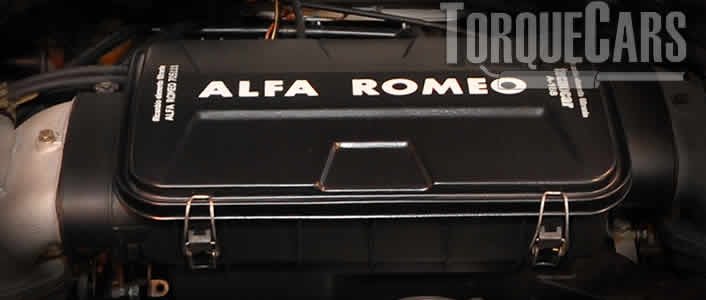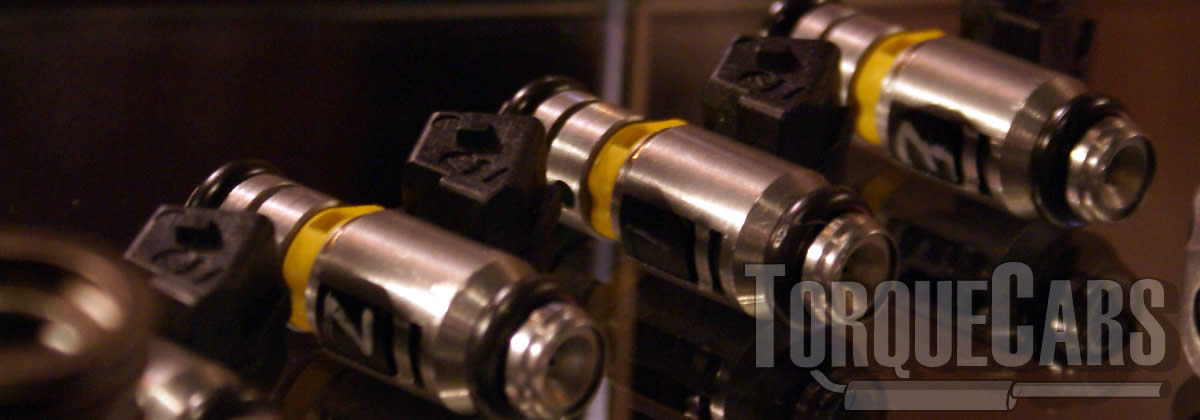Tuning the Alfa Romeo Boxer
"All you need to know about tuning and performance parts on the Alfa Romeo Boxer engine!"
Carref prides itself on providing the latest tips and guides to your modification project.
The Alfa Romeo Boxer are popular tuning projects and with carefully picked performance parts like remaps, turbo kits and camshafts you will really maximise your driving opportunities.
The Alfa boxer engine sounds fantastic, and the early 1400 with double barrel carbs was an aural delight when the tuning was spot on.
In this article we provide a guide to Boxer tuning and point out the best mods that work.
We rely on our visitors to pass on tips and tell us about their projects and what worked on their car, and this article is the culmination of the feedback we have received. First let us look at the history and specs of this engine and then consider which tuning modifications work best on it.
History of the Engine
This was a flat 4 piston engine ideally suited to low engine bays, where power was required. It was replaced with the transverse Twin Spark units around 1996.
This successful engine enjoyed a 26 year production run, and saw fuel injection, 16v and quad cam versions in it's many refinements and upgrades.

The engine first appeared in 1971 as 1200cc unit, then by stroking the engine a 1300cc unit was released in 1977 and a 1351cc version 1978.
In October of 1986 we saw a 1500cc version of this engine which was even adopted by Nissan for the Cherry in Europe.
1600 -101hp
- 1994–1997 Alfa Romeo 145
- 1995–1997 Alfa Romeo 146
1700 -116hp
- October 1986 – 1995 Alfa Romeo 33
- October 1986 – 1989 Alfa Romeo Sprint
1700 16V -135hp
Bosch Motronic ML 4.1 ECU & fuel injection system.
- January 1990 – 1995 Alfa Romeo 33 (2nd generation)
- 1994–1997 Alfa Romeo 145
- 1995–1997 Alfa Romeo 146
Tuning the Alfa Romeo Boxer and best Boxer performance parts.
What are the most effective Boxer upgrades
When talking about the best top for your Boxer engine, we are going to focus on the parts that give the best power gain for you money.
The cam profile plays a big part in the engines power output so cam upgrades make quite a large difference. The intake and exhaust durations will alter depending on the chosen cam profile, so large torque gains are on offer for cam upgrades.

Fast road camshafts usually raise the bhp through the rpm band, you may lose a little bottom end bhp but the high end rpm power will improve.
Motorsport camshafts, raise the high end rpm power band but as a result the car will not idle smoothly and low end power nearly always suffers.
A Race cam is not great in heavy traffic.
You should ideally match your bhp range to your preferences so for a typical daily driver stick with a fast road Boxer cam

Some Boxer engines respond better to less aggressive cam durations so set your engine up on a rolling road.
The ecu map and injectors and fuel pump also have an effect on the power gains you'll make.
Altering valve durations can alter the power band and on most engines the exhaust and intake durations do not need to match, although most cams and tuners use matched pairs there are some advantages to extending the intake or exhaust durations.
Please watch our introduction Video tutorial to car tuning. Be sure to subscribe and support our new channel.
How to tune your car
- Improve the handling
Focus on Suspension improvements, such as coilovers and make sure the bushings are in good order and that the alignment is correct. Then focus on improving the brakes, with a big disk brake conversion kit and fast road brake pads.
- Remove restrictions
Focus on the intake and exhaust with filters being the common point of restriction in a tuned car. Intercoolers may also become restrictive on turbo engines so this may also need to be uprated.
- Burn more fuel & air
Increase the fuelling so it matches the air coming into the engine. The ratio is important so you need to improve the fuel pump and injectors, so the head mods, big valve conversions, fast road camshafts and forced induction upgrades extra supply of air is adequately met.
- Test and replace any weak parts
Weak areas are commonly the clutch, the turbocharger and pistons and crankshaft in a highly tuned engine. Makes sure these components will cope with your power aspirations.
- The Tune or Remap
A cars ECU controls the fuel, timing, spark and even the turbo in some cases, so to fully extract your gains you should remap the car last and this will fully release the power. Some cars are easy to map, and others require piggyback ECU's or aftermarket ECU's but this is the most vital step of your tuning project.
Modifying to Stage 1:
Intake headers, Panel air filters, Sports exhaust manifold, Remaps/piggy back ECU, Drilled & smoothed airbox, Fast road camshaft.
Modifying to Stage 2:
high flow fuel injectors, Ported and polished head, Sports catalyst & performance exhaust, induction kit, fuel pump upgrades, Fast road cam.
Modifying to Stage 3:
Adding or Upgrading forced induction (turbo/supercharger), Competition cam, Twin charging conversions, Internal engine upgrades (head flowing porting/bigger valves), Engine balancing & blueprinting, Crank and Piston upgrades to alter compression.
Mapping should help to fully realize the full potential of all the mods you've done to your Boxer.
It will usually give around 30% more power on turbocharged vehicles and you can expect to see around 15% on NASP engines, but your results usually depend much on the mods you've applied and the condition of your engine.
It is the whole point to any engine performance tuning job to shove more fuel and air into each cylinder
Intake manifold transmit the air from the air cleaner and allow it to be sucked into the engine cylinders with fuel for the squish phase.
The size of bore and shape and rate of flow of the Air Intake manifolds can make a large change to fuel delivery on the Boxer.
On popular production engines intake are in dire need of aftermarket parts, although some makers provide reasonably good intake.
Big valve conversions on the Boxer, carrying out port work and head flowing will also boost torque, and significantly will give you increasing the torque increase on other modifications.
Which turbo upgrades are best?

NASP engines need quite a lot of work when you add a turbo, so we have a separate guide to help you take into account the pros and cons of going this route on your Boxer
The more air you can get into an engine, the more fuel it can burn and uprating the induction with a turbocharger upgrade makes significant power gains.
If your car is turbo charged tuning mods are going to make more power and you will discover turbocharged engines will have harder and stronger components.
There are reliable limits for every engine, with some being extremely strong and some only just able to handle stock power
See where you'll find these limits and fit better quality components to cope with the power.
We've seen people spending a fortune on turbo upgrades on the Boxer only to experience the car explode just after it's completed.
Big capacity turbos tend to experience a bottom end lag, and little turbos spool up more quickly but do not have the top end power band gains.
Thankfully the market of turbo chargers is always increasing and we commonly find variable vane turbo chargers, permitting the vane profile is altered according to speed to lower lag and increase top end bhp and torque.
Twin scroll turbo chargers divert the exhaust gases into two channels and feed these at differently angled vanes in the turbo. They also boost the scavenging effect of the engine.
It is not unusual that there is a restriction in the air flow sensor MAP/MAF/AFM on these engines when a lot more air is being sucked into the engine.
We see 4 bar air sensors coping with quite large power gains, whereas the OEM air sensor was restricting bhp and torque at a much lower level.
Adding a supercharger or additional turbo will make large power gains, although harder to configure. We have this in depth look at twinchargers if you want to read more.
Fuelling
You will need to ensure that the engine is not starved of fuel so should increase the fuelling when you start exceeding 20% of a power increase. We would recommend you to be generous with your injectors flow rate.
We would recommend you to be generous with your injectors flow rate.
The rule of thumb is to add 20% capacity when specifying an injector, this allows for injector deterioration and allows you some spare capacity should the engine require more fuel.
We think this one is common sense, but you'll need to match your fuel injector to the type of fuel your car uses as well.
All the following flywheel power targets will assume an injector duty cycle of 80% and a base of 58psi of fuel pressure at idle.
4 Cylinder turbocharged engines
- 58 PSI 170cc/min 100hp
- 58 PSI 340cc/min 200hp
- 58 PSI 511cc/min 300hp
4 Cylinder NASP engines
- 58 PSI 143cc/min 100hp
- 58 PSI 285cc/min 200hp
- 58 PSI 426cc/min 300hp
Choosing the right performance exhaust
One of the most common mistakes and problems we see in tuning projects is usually down to the exhaust, or rather a poorly chosen exhaust for your engine.
You should look to improve your exhaust if your exhaust is actually causing a flow problem.
On most factory exhausts you'll see your flow rate is still good even on modest power gains, but when you start pushing up the power levels you will need to get a better flowing exhaust.
Sports exhausts increase the flow of gases through the engine.
But if your exhaust pipe is too large, ie: over 2.5 inches bore, you will lose much of your flow rate and end up lacking power and torque.
Common exhaust restrictions come around the catalysts installed, so adding a freer flowing high performance alternative will help avoid this restriction.
Weak spots Issues & problem areas on the Boxer
The Boxer engines are generally reliable and solid as long as they are regularly serviced and maintained.
Regular oil changes are vital on the Boxer, especially when tuned and will help extend the life and reliability of the engine.
For more information on Tuning your Boxer engine please join us in our friendly forum where you can discuss tuning options in more detail with our worldwide members, or read our tuning articles to get a full grasp of the benefits and drawbacks of each modification.
Please help us improve these tips by sending us your feedback in the comments box below.
We love to hear what our visitors have got up to and which tuning mods work best for them on each model of car. Comments are used to improve the accuracy of these Boxer articles which are continually updated.
If you liked this page please share it with your friends, drop a link to it in your favourite forum or use the bookmarking options to save it to your social media profile.
Check out TorqueCars new YouTube channel, and see their awesome new content...
Feedback
Please use our forums if you wish to ask a tuning question, and please note we do not sell parts or services, we are just an online magazine.
Help us improve, leave a suggestion or tip
